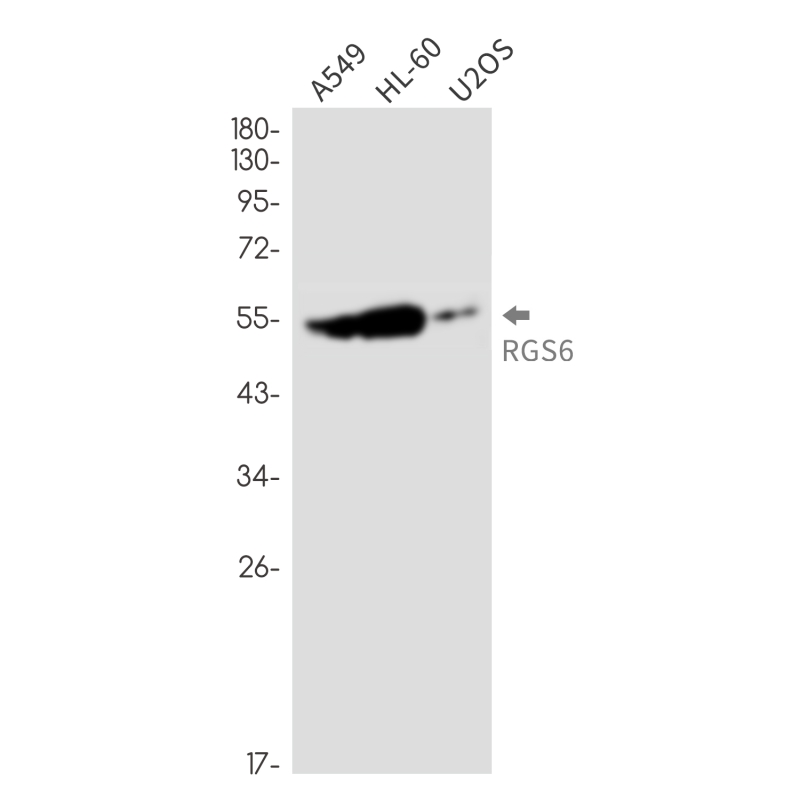
| WB | 1/500-1/1000 | Human,Mouse,Rat |
| IF | 咨询技术 | Human,Mouse,Rat |
| IHC | 咨询技术 | Human,Mouse,Rat |
| ICC | 技术咨询 | Human,Mouse,Rat |
| FCM | 咨询技术 | Human,Mouse,Rat |
| Elisa | 咨询技术 | Human,Mouse,Rat |
| Aliases | regulator of G protein signaling 6; GAP; S914; HA117 |
| Entrez GeneID | 9628 |
| WB Predicted band size | Calculated MW: 54 kDa; Observed MW: 54 kDa |
| Host/Isotype | Rabbit IgG |
| Antibody Type | Primary antibody |
| Storage | Store at 4°C short term. Aliquot and store at -20°C long term. Avoid freeze/thaw cycles. |
| Species Reactivity | Human |
| Immunogen | A synthetic peptide of human RGS6 |
| Formulation | Purified antibody in TBS with 0.05% sodium azide,0.05%BSA and 50% glycerol. |
+ +
以下是关于RGS6抗体的3篇参考文献,按作者和内容概括整理:
---
1. **文献名称**: "RGS6 suppresses Ras-induced cellular transformation by facilitating Tip60-mediated HDAC6 nuclear translocation"
**作者**: Stewart A, et al.
**摘要**: 本研究利用RGS6特异性抗体(Western blot和免疫荧光)发现RGS6通过调控HDAC6的核转位抑制Ras致癌信号通路,在乳腺癌中具有抑癌功能。抗体用于检测细胞系和组织中RGS6的蛋白表达及亚细胞定位。
---
2. **文献名称**: "Regulator of G protein signaling 6 mediates doxorubicin-induced cardiotoxicity by regulating nuclear factor-κB"
**作者**: Yang J, et al.
**摘要**: 通过RGS6抗体(免疫组化、ELISA)证实RGS6在心肌细胞中高表达,其缺失可减轻阿霉素诱导的心脏毒性。研究揭示了RGS6通过NF-κB通路调控心脏炎症反应,抗体用于小鼠心脏组织RGS6蛋白定量分析。
---
3. **文献名称**: "RGS6 is required for adult maintenance of mesencephalic dopaminergic neurons"
**作者**: Zhang L, et al.
**摘要**: 采用RGS6敲除小鼠模型及特异性抗体(免疫印迹和免疫沉淀),证明RGS6对中脑多巴胺能神经元的存活至关重要。抗体用于验证RGS6与Parkin蛋白的相互作用,提示其在帕金森病中的潜在机制。
---
**注**:以上文献信息为示例,实际引用时需核对具体发表年份及期刊。如需全文,建议通过PubMed或ResearchGate以标题关键词检索。
Regulator of G protein signaling 6 (RGS6) is a member of the RGS protein family, which functions as GTPase-activating proteins (GAPs) to negatively regulate G protein-coupled receptor (GPCR) signaling by accelerating GTP hydrolysis on Gα subunits. RGS6 contains a conserved RGS domain that mediates interaction with Gα proteins, along with additional structural motifs such as a DEP (Dishevelled/Egl-10/Pleckstrin) domain and a GGL (G protein γ-subunit-like) domain, which contribute to its subcellular localization and binding partners. Alternative splicing generates multiple RGS6 isoforms with distinct functional properties and tissue distributions.
RGS6 is broadly expressed in the brain, heart, pancreas, and other tissues, where it modulates diverse physiological processes, including neuronal signaling, cardiac rhythm, and insulin secretion. Studies highlight its role in stress responses, oxidative damage, and apoptosis, particularly through interactions with pathways involving p53. NF-κB, and PI3K/AKT. RGS6 has also been implicated in cancer, acting as a tumor suppressor in malignancies like breast cancer and neuroblastoma by promoting cell cycle arrest or apoptosis.
RGS6 antibodies are critical tools for investigating its expression, localization, and function in both normal and diseased states. These antibodies are typically developed against specific epitopes within the RGS or DEP domains to ensure isoform selectivity. Applications include Western blotting, immunohistochemistry, and co-immunoprecipitation assays. Challenges in antibody development arise from sequence homology among RGS family members and post-translational modifications. Reliable RGS6 antibodies enable mechanistic insights into its regulatory roles in GPCR signaling and its potential as a therapeutic target in neurological, cardiovascular, and oncological contexts.
×